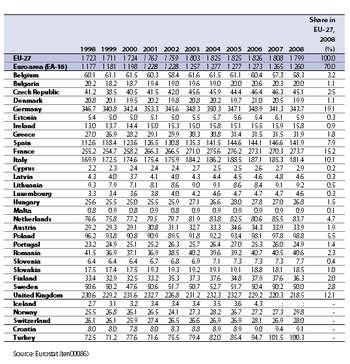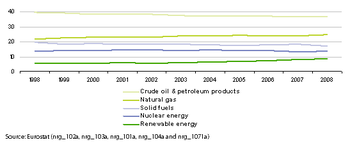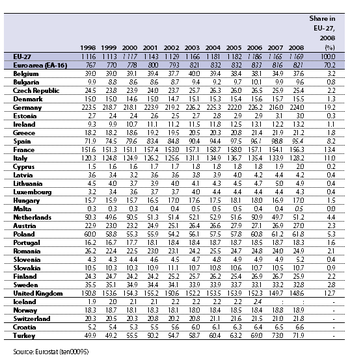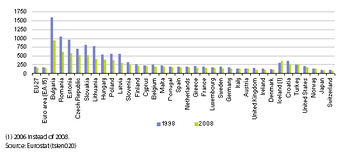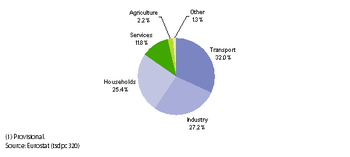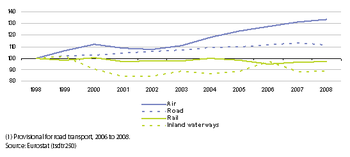Archive:Consumption of energy
- Data from September 2011, most recent data: Further Eurostat information, Main tables and Database.
This draft article has been updated for the 2012 edition of the ESTAT yearbook and is ready for review – please see the talk/discussion page for more detailed information.
The European Union (EU) has pledged to cut its energy consumption by 20 % (compared with projected levels) by 2020. This article explains how the consumption of energy in the EU has evolved, highlighting a gradual shift from fossil fuels to renewable energy sources, such as solar energy, wind power, and biofuels; it also looks at the evolution of energy use by various transport modes.
In tandem with supply-side policies, the EU has launched a number of initiatives which aim to increase the efficiency of energy use, reduce energy demand and attempt to decouple it from economic growth. Several instruments and implementing measures exist in this field, including the promotion of co-generation, the energy performance of buildings (whether private or public buildings), and energy labelling of domestic appliances.
Main statistical findings
Consumption
Gross inland energy consumption of primary energy within the EU-27 in 2009 was 1 703 million tonnes of oil equivalent (toe). While gross inland consumption had remained relatively unchanged throughout the period from 2003 to 2008 the data for 2009 indicate a substantial decrease, -5.5 % compared with 2008 (see Table 1); much of the decrease may well be attributed to a lower level of economic activity as a result of the financial and economic crisis, rather than a structural shift in the pattern of energy consumption.
The gross inland consumption of each Member State depends, to a large degree, on the structure of its energy system, the availability of natural resources for primary energy production, and the structure and development of each economy (general trends in economic growth); this is true not only for conventional fuels and nuclear power, but also for renewable energy sources. Despite falls in 2009 in the majority of the EU Member States, gross inland consumption of primary energy had increased at a rapid annual average rate in Luxembourg and Cyprus throughout the period from 1999 to 2009, and at a slower average rate in Greece, Austria and Spain. The largest reduction in gross inland consumption of primary energy (during the same ten-year period) was recorded in the United Kingdom (-10.1 %).
Over the period 1999 to 2009 there was a gradual decline in the share of crude oil and petroleum products, solid fuels, and nuclear energy in total gross inland consumption, while an increasing share of EU-27 consumption was accounted for by natural gas and renewable energy sources (see Figure 1). The combined share of crude oil, petroleum products and solid fuels fell from 57.5 % of total consumption in 1999 to 52.3 % in 2009, reflecting changes in the EU-27’s energy mix and a move away from the most polluting fossil fuels. During the same period, the relative importance of natural gas rose by 2.1 percentage points, reaching 24.5 % of the EU-27’s gross inland consumption by 2009 while the relative importance of renewable energy sources rose 3.5 percentage points to reach 9.0 %. The relative importance of renewable energy sources was over one third of gross inland consumption in Latvia (36.2 %) and Sweden (34.4 %), and was over one quarter of the total in Austria (27.3 %).
EU-27 final energy consumption (in other words, excluding energy used by power producers) was equivalent to just under two thirds (65.4 %) of gross inland consumption, at 1 114 million toe in 2009. Almost one fifth (19.2 %) of the EU-27’s final energy consumption was accounted for by Germany (see Table 2).
The lowest levels of energy intensity – a measure of an economy’s energy efficiency – were recorded for Denmark and Ireland in 2009, while the most energy-intensive Member States were Bulgaria, Estonia and Romania (see Figure 2). It should be noted that the economic structure of an economy plays an important role in determining energy intensity, as post-industrial economies with large service sectors will, a priori, have considerably lower energy use than economies characterised by heavy, traditional industrial activities. Between 1999 and 2009, substantial energy savings were made in the Bulgarian and Romanian economies, as well as in the Baltic Member States, Malta, Poland and Slovakia, as the amount of energy required to produce a unit of economic output (as measured by gross domestic product (GDP)) was reduced by 25 % or more; Ireland, Sweden and the United Kingdom also achieved reductions of just under one quarter.
End-users
An analysis of the final end use of energy shows three dominant categories, namely, transport, industry and households. The share consumed by transport was around one third of the EU-27’s final energy consumption in 2009 (see Figure 3), while the shares of households and industry were nearer to one quarter. The total energy consumption of all transport modes in the EU-27 amounted to 367.6 million toe in 2009. There were, however, considerable differences in the development of energy consumption across transport modes, with the most rapid growth recorded for international aviation (18.9 % between 1999 and 2009) and an upward trend for road transport (7.3 %) and domestic aviation (5.0 %), while the energy consumption of rail fell 14.5 % and that of inland waterways by 5.6 % – see Figure 4. The largest increase in energy consumption among the different transport modes, in absolute terms, was recorded for road transport, where EU-27 consumption rose by 20.4 million toe between 1999 and 2009, compared with a 6.8 million toe increase for international aviation and a 0.4 million toe increase for domestic aviation. These changes in energy consumption reflect the use of each transport mode, but can also be influenced by technological changes, especially when these relate to fuel-efficiency gains.
Data sources and availability
Gross inland energy consumption represents the quantity of energy necessary to satisfy inland consumption of the geographical entity under consideration. It may be defined as primary production plus imports, recovered products and stock changes, less exports and fuel supply to maritime bunkers (for seagoing ships of all flags). It describes the total energy needs of a country (or entity), covering: consumption by the energy sector itself; distribution and transformation losses; final energy consumption by end-users; and statistical differences.
Final energy consumption includes the consumption of energy by all users except the energy sector itself (whether for deliveries, for transformation, and/or its own use), and includes, for example, energy consumption by agriculture, industry, services and households, as well as energy consumption for transport. It should be noted that fuel quantities transformed in the electrical power stations of industrial auto-producers and the quantities of coke transformed into blast-furnace gas are not part of overall industrial energy consumption but of the transformation sector.
Energy intensity is measured as the ratio between gross inland consumption of energy and GDP; this indicator is a key indicator for measuring progress under the Europe 2020 strategy for smart, sustainable and inclusive growth. The ratio is expressed in kilograms of oil equivalent (kgoe) per EUR 1 000, and to facilitate analysis over time the calculations are based on GDP at constant prices (currently chain-linked 2000 prices). If an economy becomes more efficient in its use of energy and its GDP remains constant, then the ratio for this indicator should fall. The economic structure of an economy plays an important role in determining energy intensity, as post-industrial economies with large service sectors will, a priori, display relatively low energy intensity rates, while developing economies may have a considerable proportion of their economic activity within industrial sectors, thus leading to higher energy intensity.
Context
As well as supply-side policies do influence the production of energy, there is a growing trend for policy initiatives to focus on improving energy efficiency in an attempt to reduce energy demand and decouple it from economic growth. This process was given impetus by the integrated energy and climate change strategy that committed the EU to cut its energy consumption by 20 % by 2020 (in relation to projected levels) and, in so doing, simultaneously address the issues of import dependency, energy-related emissions, and energy costs. The European Commission adopted the ‘Energy Efficiency Plan 2011’ (COM(2011) 109 final) in March 2011. The stated aim is to pursue this plan in conjunction with other policy actions under the Europe 2020 flagship initiative for a resource-efficient Europe, including the ‘Roadmap for moving to a competitive low carbon economy by 2050’’ (COM(2011) 112 final) – see the introduction to the environment chapter. The energy efficiency plan proposes several actions to:
- promote the exemplary role of the public sector and propose a binding target to accelerate the refurbishment rate of the public sector building stock; introduce energy efficiency criteria in public procurement;
- trigger the renovation process in private buildings and improve the energy performance of appliances;
- improve the efficiency of power and heat generation;
- foresee energy efficiency requirements for industrial equipment, improved information provision for SMEs, and energy audits and energy management systems for large companies;
- focus on the roll-out of smart grids and smart meters providing consumers with the information and services necessary to optimise their energy consumption and calculate their energy savings.
The EU harmonises national measures relating to the publication of information on the consumption of energy by household appliances, thereby allowing consumers to choose appliances on the basis of their energy efficiency – a range of different products (for example, light bulbs, refrigerators, washing machines) carry the EU’s energy label that details the energy efficiency of products, rating them according to a scale that ranges from A to G, with 'A' as the most energy efficient products and 'G' the least efficient.
Despite falls in the amount of energy consumed for transport in 2008 and 2009 (at least, in part, reflecting the impact of the financial and economic crisis), an analysis of a longer time series shows that transport was the fastest growing consumer of energy and producer of greenhouse gases, even if advances in transport technology and fuel have resulted in marked decreases in emissions of certain pollutants. There are many factors that impact on energy use for transport, for example, overall economic growth, the efficiency of individual transport modes, the take-up of alternative fuels, and lifestyle choices. The globalised nature of the economy has fuelled demand for international freight movements (principally by ship), while within the Single Market there has been a considerable expansion in the use of road freight transport. The growth in demand for energy for transport is not confined to business, as it has been accompanied by an expansion in personal travel. The growth of low-cost airlines, an increase in motorisation rates (the average number of motor vehicles per inhabitant), a trend for living in suburban areas, or the expansion of tourism (more frequent breaks, and more long-haul destinations) are among some of the factors that have contributed to increase the demand for energy as a result of personal travel.
Further Eurostat information
Publications
- Panorama of energy: energy statistics to support EU policies and solutions
- Energy – yearly statistics
- Energy balance sheets
Main tables
- Energy, see:
- Energy Statistics - quantities (t_nrg_quant)
- Share of renewables in gross inland energy consumption (tsdcc110)
- Gross inland consumption of primary energy (ten00086)
- Gross inland energy consumption, by fuel (tsdcc320)
- Consumption of electricity by industry, transport activities and households/services (ten00094)
- Final energy consumption (ten00095)
- Final energy consumption, by sector (tsdpc320)
- Final energy consumption of petroleum products (ten00096)
- Final energy consumption of electricity (ten00097)
- Final energy consumption of natural gas (ten00098)
- Final energy consumption by industry (ten00099)
- Final energy consumption by transport (ten00100)
- Energy consumption of transport, by mode (tsdtr100)
- Final energy consumption by households, trades, services, etc. (ten00101)
- Electricity consumption of households (tsdpc310)
- Energy dependency (tsdcc310)
- Combined heat and power generation (tsien030)
- Share of biofuels in fuel consumption of transport (tsdcc340)
Database
- Energy, see:
- Energy Statistics - quantities (nrg_quant)
- Energy Statistics - supply, transformation, consumption (nrg_10)
- Supply, transformation, consumption - all products - annual data (nrg_100a)
- Supply, transformation, consumption - solid fuels - annual data (nrg_101a)
- Supply, transformation, consumption - oil - annual data (nrg_102a)
- Supply, transformation, consumption - gas - annual data (nrg_103a)
- Supply, transformation, consumption - electricity - annual data (nrg_105a)
- Supply, transformation, consumption - heat - annual data (nrg_106a)
- Supply, transformation, consumption - renewables and wastes (total, solar heat, biomass, geothermal, wastes) - annual data (nrg_1071a)
- Supply, transformation, consumption - renewables (hydro, wind, photovoltaic) - annual data (nrg_1072a)
- Supply, transformation, consumption - renewables (biofuels) - annual data (nrg_1073a)
- Energy Statistics - supply, transformation, consumption (nrg_10)
Methodology/Metadata
- Energy Statistics - quantities (ESMS metadata file - nrg_quant_esms)
- Share of renewable energy in fuel consumption of transport (ESMS metadata file - tsdcc340_esms)
Source data for tables and figures (MS Excel)
External links
- European Commission - Energy - Energy policy for a competitive Europe
- European Commission - Mobility & Transport - European strategies
- International Energy Agency (IEA) - World Energy Outlook
- OECD - Energy - Climate Change, Energy and Transport
